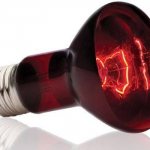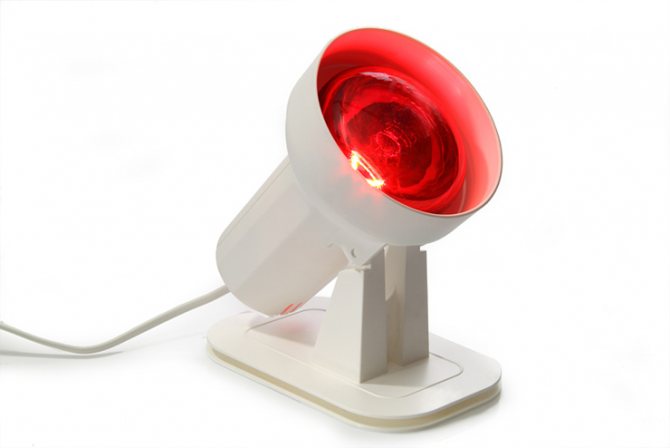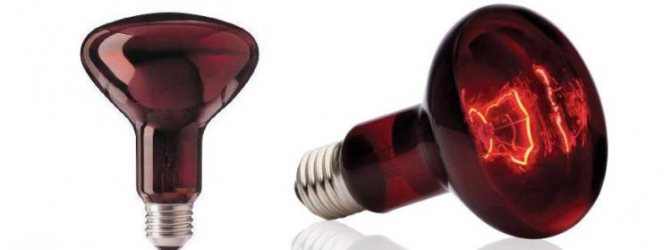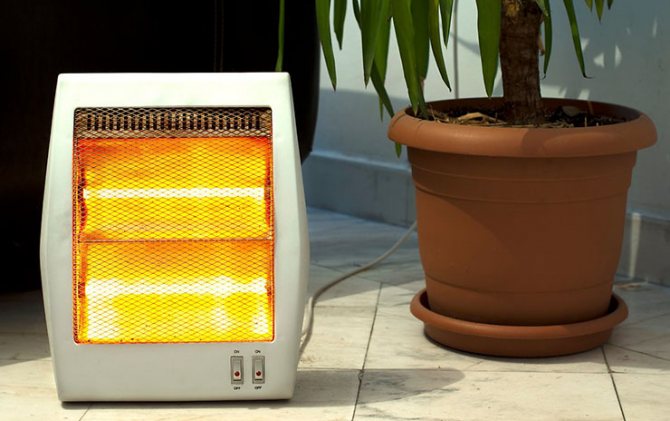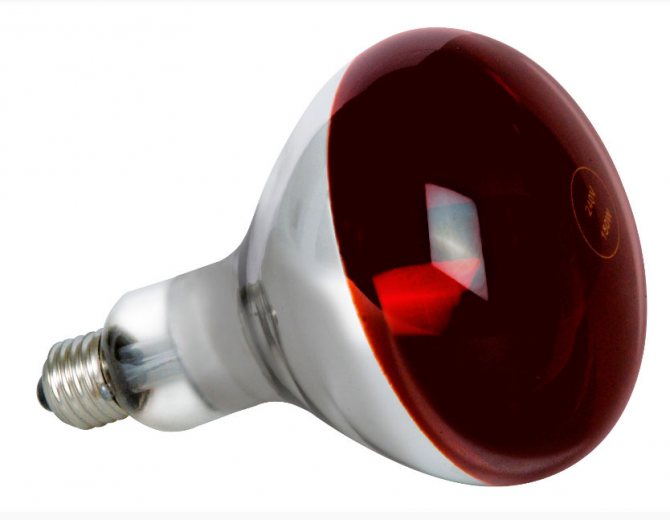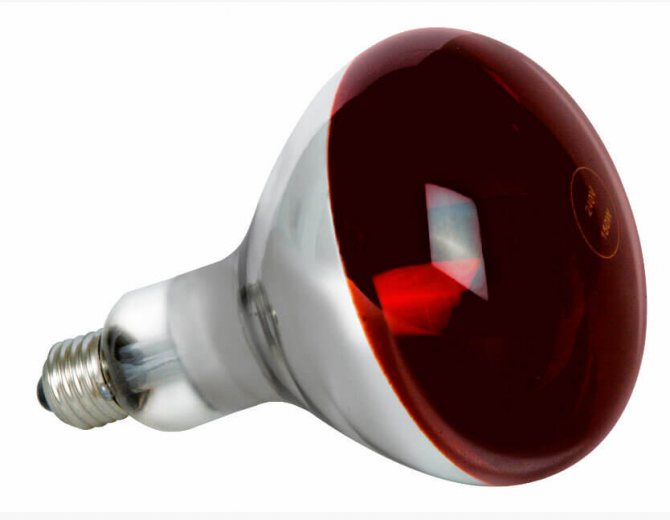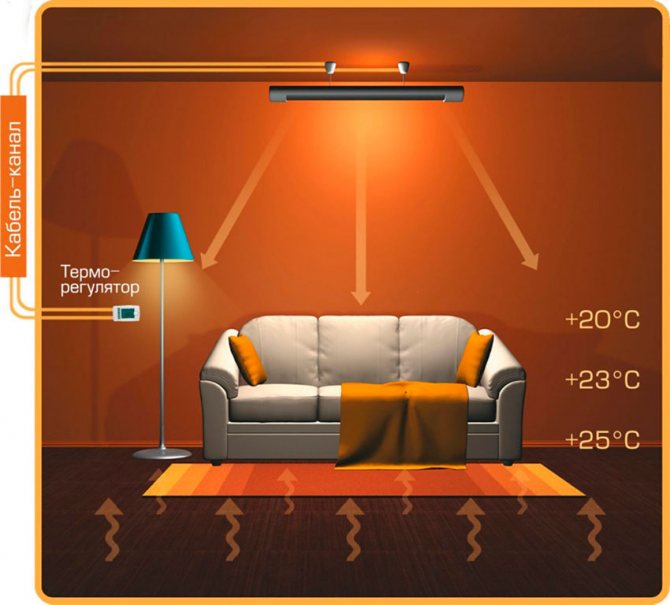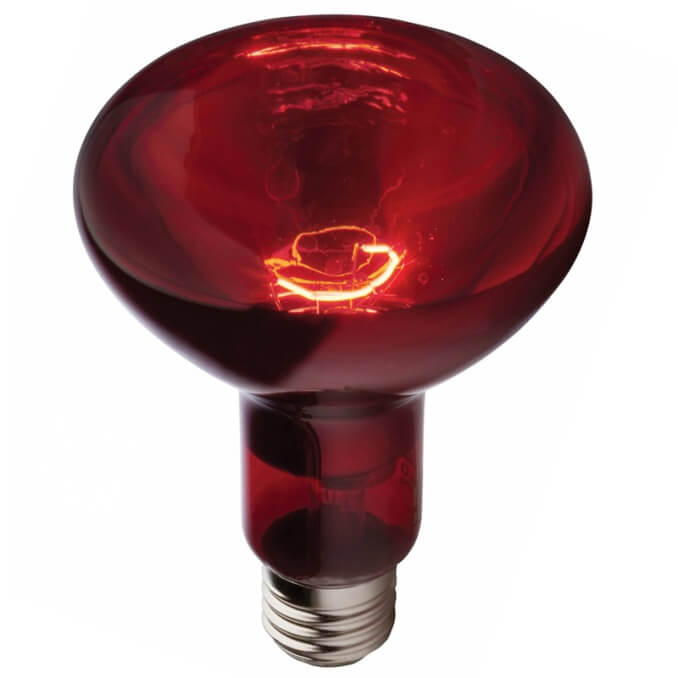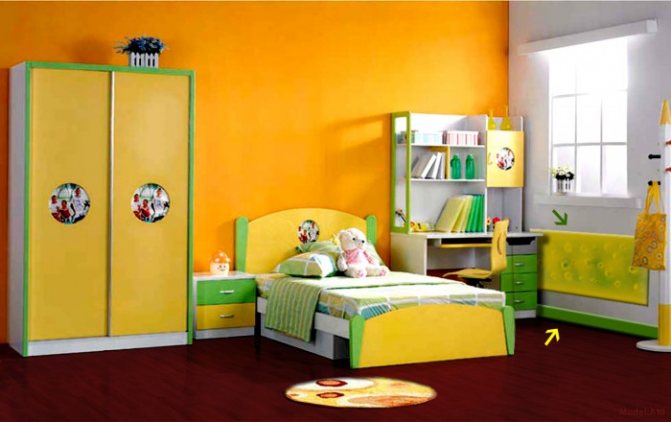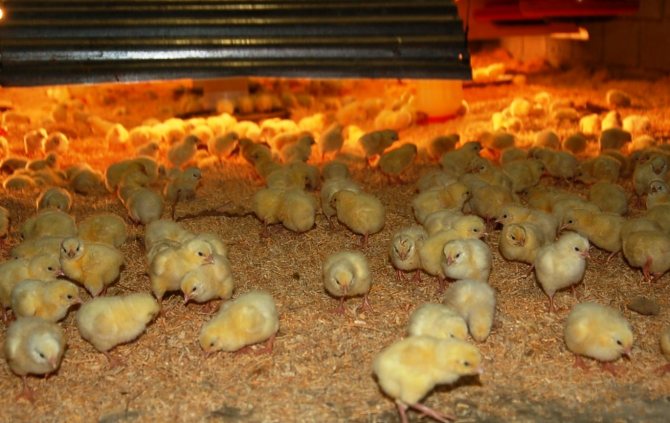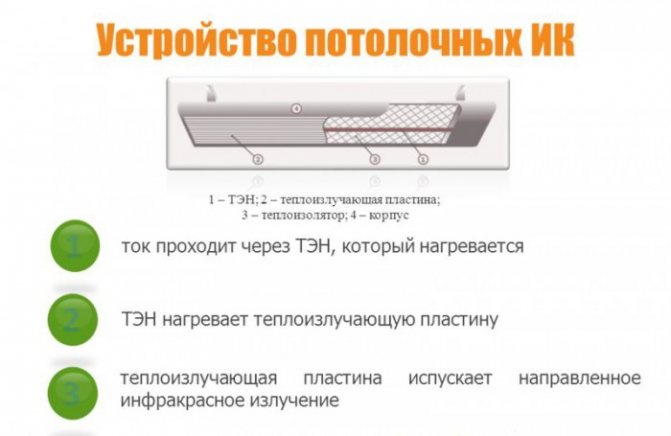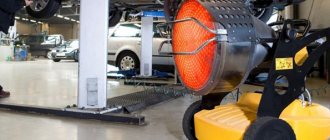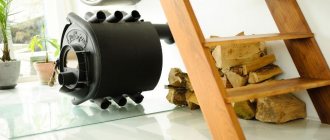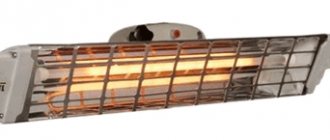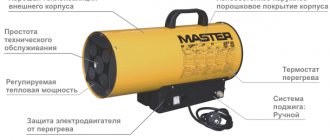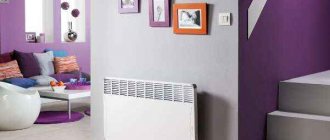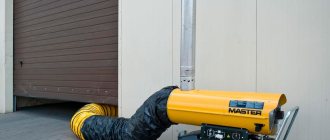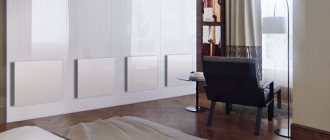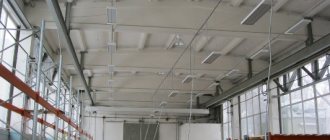Infrared lamp design
Infrared heating lamps are autonomous heating devices that are powered from the electrical network. They are a source of infrared radiation that reaches the surrounding objects and heats them up. The simplest version of the device is presented in the form of a simple glass bulb with a tungsten filament inside. Glass is often stained with a brownish red color. From the inside you can see a mirror finish. Such a light bulb is screwed into a socket, enclosed in a housing or suspended above the heated space.
There are compact infrared lamps for heating rooms, which are made in the form of thin glass tubes - a mixture of argon and nitrogen is pumped into them. The result is a miniature light bulb with a decent heat flow. It functions thanks to a tungsten filament, like an ordinary light bulb, which is designed to illuminate rooms.
An infrared heating lamp is a compact source of infrared radiation with a power of 50 to 500 W, although more powerful devices that are used in heaters can be found on sale. During operation, the body of the device can warm up to high temperatures, for this reason, the cartridge of the device should not be made of plastic, otherwise it will soon melt. Do not touch the infrared lamps, as there is a possibility of getting burned.
What is infrared heating
Each body, the temperature of which is higher than the surrounding objects, gives them heat. This happens in the following ways:
- through the places of contact of surfaces;
- through a liquid or gas from their contact with a warm body;
- electromagnetic radiation of waves.
If there are no contacts for transferring heat, then the heated body is an infrared heater. It emits invisible infrared rays, which are the same as light. Their spectrum lies between short radio waves and red light visible to the human eye.
Principle of operation
The principle of operation used in infrared lamps was invented by nature itself. Everyone is well aware that the most powerful source of infrared radiation is the Sun. Its rays reach the surface of the Earth and objects located on it, warming them up. As a result, they begin to release heat into the air. It turns out that not the air itself, which is a good heat insulator, heats up from the sun's rays, but the elements of the landscape and buildings that were created by mankind.
Infrared lamps for the home work in a similar way. Infrared rays, instantly reaching any objects, are absorbed by them, after which they are converted into thermal energy. For this reason, by placing your hand under the light source, you can feel the spreading warmth inside yourself. Devices of this type warm up the premises more efficiently than many analogs and at the same time do not waste energy.
The brighter the device shines, the more short-wave radiation it gives, and the further its rays propagate - thanks to this, it is possible to heat rooms with a large area. Longwave models are not as bright, but they radiate more gentle and softer warmth. Radiation from such lamps does not have a detrimental effect on living organisms, including humans - provided that they are used wisely. Several types of devices are used for physiotherapy purposes to treat various diseases.
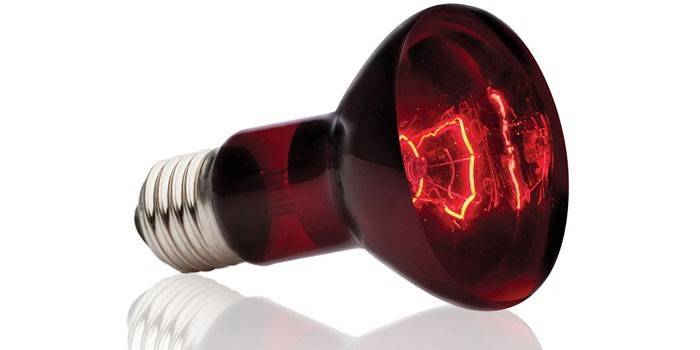
Operating principle
Infrared lamps work in a similar way to the sun, a natural source of infrared radiation.The waves reach directly objects in the room (walls, animals or people), and then pass into heat. Almost no power is spent on heating the air, as is the case when using classic heating appliances. To feel the warmth, just place your hand under the glass flask without touching it. This makes IR lamps very economical.
The device is operated in three simple steps:
- A current is supplied to the emitter.
- The spiral starts to heat up.
- Infrared light is produced.
The brightness of the lamp and the wavelength are inversely related. The heated area also depends on this. In bright lamps, the waves are short, which allows them to propagate further, and the served area increases. Long wavelength radiation is the opposite, but it produces softer heat.
When used judiciously, the radiation from these heating devices does not harm living organisms in any way. This also applies to humans, therefore, such heaters are widely used at home and in medical institutions.
Types of IR lamps
Modern manufacturers offer several varieties of IR lamps to choose from. There are four of them:
- without mirror coating;
- with a mirrored coating - they are distinguished by silver bulbs;
- with red mirror finish;
- with blue mirror finish.
The first types of bulbs are similar in appearance to conventional incandescent bulbs, but they are also a source of infrared radiation. Powerful luminous heating elements (electric heating elements), which are equipped with halogen infrared heaters, are also lamps, but they are more efficient and are intended for heating rooms with large areas.
- Use of hormonal pills
- Fat Burning Sports Diet
- Pain in the left hypochondrium
Other types of bulbs are supplied with a special mirror coating. Such a coating is necessary to improve the efficiency of devices and in order to direct the infrared stream in a certain direction. In the absence of a reflective coating, external reflective elements can be used as it - this is implemented in halogen infrared heaters. Sometimes IR lamps are combined into one structure to create a powerful IR illuminator.
In addition, the traditional infrared lamp in the form of a conventional light bulb under the E27 base has a specific marking in the form of an abbreviation. The designation "IKS" means that the product is not painted in any colors and can be used not only for heating rooms, but also for lighting. The abbreviation "IKZK" indicates the presence of a red color, and "IKZS" indicates that the product is blue. IR devices also differ from each other in several characteristics, which include:
- Chuck type (base). Equipped with a traditional size E27 chuck.
- Wavelength. Depending on this parameter, the devices are long-wave, medium-wave and short-wave.
- Power. Varies over a very wide range.
- Supply voltage. For almost all household IR bulbs, this figure is 220 volts.
How to apply correctly
Before starting the warm-up procedure, install the lamp in a convenient place near a household outlet so that you can comfortably approach it.
How to use an IR lamp:
- Before starting the procedures, a sound timer is always set, since during warming up the person relaxes and can fall asleep. The patient is positioned at a distance of 30 to 50 cm from the heater.
- During the session, the direction of the device or the body is changed in order not to be burned.
- The heating temperature should be comfortable, the heating is carried out until slight reddening of the skin, the duration of the procedure is agreed with the attending physician.
- Usually, a procedure is used from five to ten minutes per session.
It will be interesting for you Connecting a switch with an LED with your own hands
Warnings during use:
- You cannot use the head heating procedure for more than 5 minutes in one session, the interval between procedures should be at least two hours.
- It is forbidden to look at the emitter.
- It is necessary to move or disconnect the device if a burning sensation is felt.
- It is not recommended to use the device in case of injury within the first 24 hours.
- Before the procedure, do not use essential oils, lotions or creams that can cause burns.
- Do not touch the IL when it is hot.
- Do not screw the device too tightly into the base, otherwise it may burst.
- Infrared therapy is contraindicated in certain skin cancers that may be exacerbated by intense light.
Benefits
The IR lamp has several important advantages that have made it grow in popularity from year to year. They consist in:
- Complete noiselessness of work. Compared to heat guns, infrared radiation spreads without any fans or other devices.
- Maximum efficiency (efficiency). Like most other electric heating devices, it approaches 100 percent - this figure does not reach due to certain laws of physics.
- Spot heating capabilities. This is true for animals that are kept in pens, small cages. For example, "IKZK" is widely used in the field of animal husbandry, where they are used to heat poultry houses, pigsties and other places where animals are kept.
- Compactness. A standard 500W IR lamp is comparable in size to a conventional incandescent lamp.
- Simplest installation. You need to screw the infrared lamp into the socket, and then flip the switch.
- Environmental friendliness. IR devices do not burn oxygen and do not emit any gases into the surrounding area.
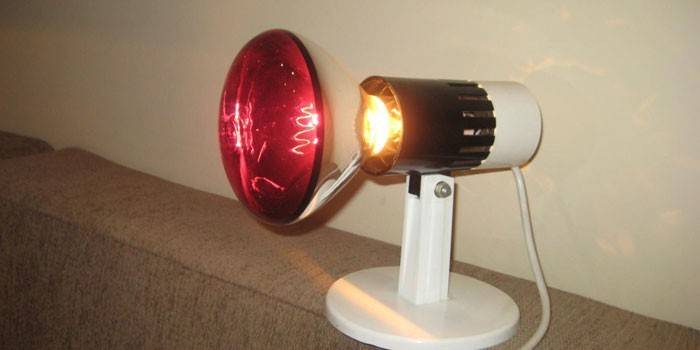

Design features of case IR heaters
The design of IR heaters is quite simple and represents a steel body painted with powder paint, in which a heating element (ceramic, carbon (quartz), halogen, tubular (micathermic)) is installed.
Ceramic heater is a resistive conductor enclosed in a ceramic plate, which contains silicon carbide, molybdenum disilicide or lanthanum chromite. The conductor can be made of nichrome (the maximum heating temperature is about 1000 0C) or fechral (with a heating temperature of 800 0C). The average service life of such devices is 4 years.
Figure 4 - Ceramic heating element for IR heaters
IN carbon heating element a spiral carbon (carbon) thread, which can be heated up to 3000 ° C, is placed in a vacuum quartz tube (this is necessary in order to protect the carbon from oxidation when heated). When manufactured well, these heaters have an unlimited service life.
It should be noted that carbon infrared heaters, all other things being equal, consume less electricity for heating premises, which is explained by the high thermal conductivity of the carbon filament (for example, nichrome has this indicator more than 5 times lower).
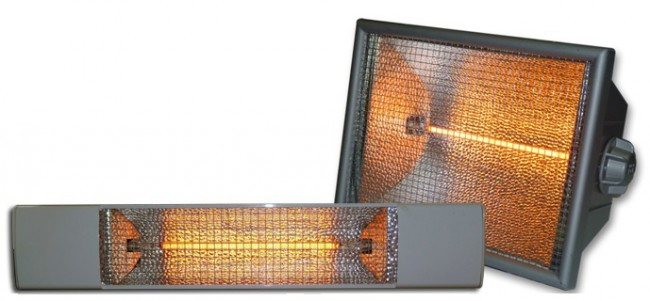

Figure 5 - Carbon infrared heater
In the literature, you can often find the term "Quartz" infrared heaters, although in fact they are carbon elements, the only difference is that a tungsten (not carbon) filament is located in a quartz tube in which a vacuum is created. Its heating temperature can be 2000 ° C.
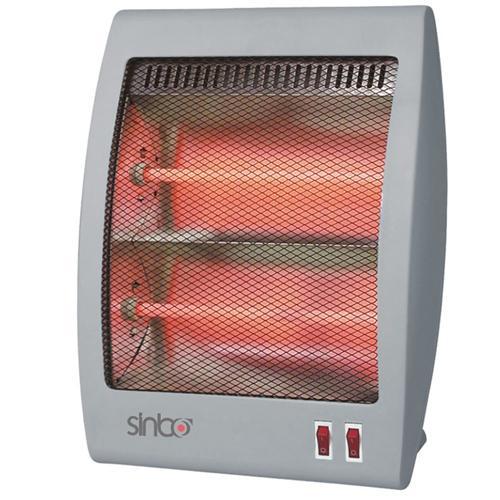

Figure 6 - Quartz IR heater
Halogen heaters structurally similar to ceramic: a tungsten filament is placed in a ceramic tube, but unlike the latter, an inert gas is pumped into it, as a result of which tungsten, when heated, settles on the filament, and not on the tube walls. Thanks to this, such infrared heaters provide the premises with heat faster.
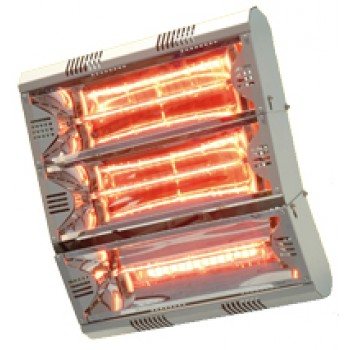

Figure 7 - Halogen IR heater
Tubular (micathermic) elementbuilt into an anodized aluminum profile (plate) is considered to be low-temperature, because its maximum heating temperature does not exceed 300 ° C. As a rule, several such plates are used in one device. The tubular lamp can have a lifespan of 7 years.
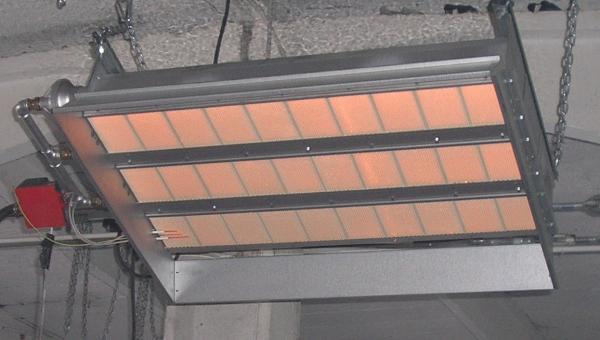

Figure 8 - Micathermic infrared heater
To provide a directed flow of heat, a reflector (reflector), usually made of aluminum, is placed in the body of the infrared heater.
In addition, most models are equipped with a thermostat (providing automatic on / off when cooling or overheating). Floor standing units often have a rollover trip sensor.
disadvantages
A device of this type, such as an infrared lamp, is not without its drawbacks. For this reason, be sure to take them into account before purchasing an infrared heating lamp. The disadvantages include:
- High power consumption. This is typical for any heating devices that are powered from the mains.
- The emergence of discomfort with prolonged exposure to light bulbs. In this case, non-compliance with certain operating standards is more often affected.
- High temperature of flasks. There is a risk of serious burns.
Types of halogen heaters
Halogen heaters are divided into:
- by destination:
- household - power up to 3 kW;
- industrial - power more than 3 kW;
- by execution:
- floor - the most common type, most often having wheels for ease of movement;
- wall-mounted - used in rooms of a small area and mounted at a height of approximately 1.5 m from the floor, while the base must be well insulated, made of heat-resistant materials;

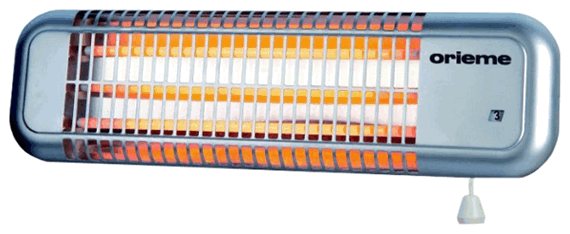
- ceiling - mounted with brackets to a regular ceiling base or having the ability to be installed in a suspended ceiling structure, take up a minimum of space, installation is advisable for a ceiling height of 3.0 m, heat-resistant thermal insulation of the base is mandatory.

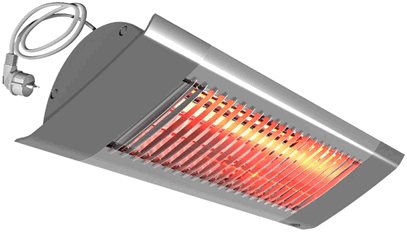
Applications for infrared lamps
Despite the disadvantages, the infrared lamp continues to be in demand for heating various rooms. The scope of its application is wide - it is necessary not only in everyday life, but also in production, in the medical industry, etc. Especially often infrared lamps are used by agricultural workers and people who specialize in breeding livestock and poultry. They also acquired some distribution for heating open areas.
For heating animals
Infrared devices are well suited for livestock breeding, so they are used in chicken coops, pigsties, cowsheds, stables, etc. Infrared radiation to heat chicks helps chicks survive and stay warm. Birds are happy to huddle right under the device, enjoying the heat released from it. In the same way, cages with animals are heated, where a thermal infrared lamp with temperature control can be useful.
Such devices are especially in demand in chicken coops. Their use helps to provide the birds with the necessary level of warmth and create a comfortable atmosphere even in extreme cold. They stop feeling discomfort from cool air and freeze. The immune system of birds grows stronger, and the risk of morbidity among them decreases sharply - this is very important for laying hens, because a comfortable, stable temperature helps them to lay eggs regularly.
The same devices are used in zoos, terrariums and on farms, where newly born animals are deposited in separate boxes, cages. To make them comfortable and warm, low-power bulbs are installed above them. In terrariums where snakes, turtles, reptiles and other amphibians live, a heat point is made using an IR lamp. It is a place where reptiles crawl out to warm themselves. Exposure to radiation for 3-5 minutes will warm up the animals, and the absence of bright light will have a positive effect on their nervous system and will preserve their sleep patterns.
- Folk signs about the weather
- Pneumosclerosis of the lungs - what is it, how to treat
- Cod liver - benefits and harms: properties for the body
For space heating
An excellent basis for an outdoor heater is a halogen infrared lamp. With a short wavelength and low power, relatively large areas are heated with its help. Heating devices, supplemented with such bulbs, are widely used on verandas, terraces, near pools. They are used even in open areas of cafes and restaurants. The infrared rays emitted by them quickly reach people, delighting them with warmth and comfort.
In outdoor conditions, they are almost the only way of heating, tk. conventional convectors, heat guns will be useless. The infrared tube heater is excellent for heating commercial and residential areas. By installing such appliances on a wall or ceiling, you get a good source of heat. A short or medium wave light bulb will quickly create a comfortable atmosphere for people to stay. Heaters of this type are rarely used on a permanent basis - they are often used as ancillary equipment in case of poor main heating.
For sauna
With the help of IR lamps, the body is warmed up from the inside, because infrared waves easily penetrate to a depth of about 4 cm, having a positive effect on joints, skin, and the system of internal organs. The use of such heaters in saunas contributes to weight loss. Excess fluids, along with toxins and toxins, are actively removed along with sweat.
At the same time, blood flow improves, and the body's energy consumption increases, which provokes the burning of calories. With regular visits to infrared saunas, you can successfully fight all sorts of skin lesions, for example, dermatitis, eczema, etc. Staying in an infrared sauna makes the walls of blood vessels elastic, reducing the risk of developing heart and some other dangerous diseases.
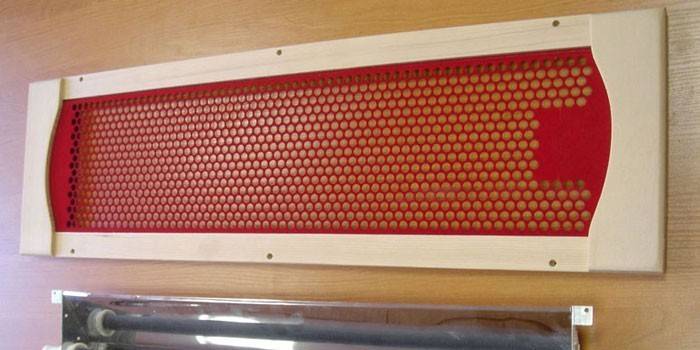

For drying paint and working with plastics
Processing different materials and drying them with an IR lamp is a profitable and practical method, which is used by both small workshops and large paint shops. Lamp drying can be done pointwise: the heat from the device is directed to the area of the object that needs to be dried, without heating its other zones. For example, drying the hood does not heat up the entire vehicle, but only the hood.
When working with plastic, radiation helps it straighten, soften, bend and shape. Additionally, they participate in shrinking, drawing, extrusion of objects from plastic, representing an effective tool. Such bulbs are also used by printing houses, where they use them to free the paper from excess moisture - drying with warming up is faster. The result is high quality printing.
For heating greenhouses
With the help of infrared radiation, the optimal atmosphere in the greenhouses is organized, because the plants receive the same rays from the sun. Such heating will be a plus for the development of crops. For this, a lamp for an infrared lamp is used or single products are adapted, which hang on wires over developing plants. This type of lamp is also suitable for those who grow seedlings on the windowsill. Plants will not lack warmth, lighting.The main thing is not to overdo it with the selection of power, the duration of the backlight.
For treatment
The treatment with infrared light bulbs has been a little forgotten. Previously, infrared lamps were widely used to eliminate pain symptoms, treat osteochondrosis, and pain in bones and muscles. They also helped with flu, throat diseases, acute respiratory infections, skin diseases and high blood pressure, through them they strengthened the immune system, relieved stress, removed bruises, and increased the body's endurance.
Nowadays, treatment with infrared lamps is gradually reviving again. People began to trust pills less, remembering the beneficial effects of physiotherapy procedures. Treatment with infrared rays belongs precisely to the field of physiotherapy. The infrared spectrum is effective in treating acne, which is important for people who are concerned about skin problems.
What is it for: types and applications
Infrared lamps can be classified according to several criteria:
- Power... The range is very wide: from 50 to 500 watts. More powerful samples can be found if necessary.
- Light wavelength (longwave, mediumwave, shortwave). Short-wavelength radiation is the brightest and can heat rooms with a large area, while long-wavelength samples are somewhat dimmer, but the heat emanating from them is softer.
- Lighting... The color of the glass is blue, white or scarlet. Additionally, a mirror finish can be applied.
- The form (the shape of an ordinary light bulb or in the form of tubes).
- Design features (incandescent, halogen).
- Application (for heating, drying, growth, treatment).
Expert opinion
Izosimov Vladimir Nikolaevich
An electrician of the highest category. Lighting specialist.
Mirror coating is used to improve the efficiency of equipment. In addition, this reflective coating helps direct the flow of light in the desired direction. Spraying can be replaced by external reflective elements.
Infrared lamps, subject to a reasonable approach and adherence to the rules of use, do not have a harmful effect on living organisms. They do not waste energy, while they are many times more efficient than many analogues. In addition to the above, IR lamps have a number of other advantages:
- They do not have fans or other devices that make noise, so IR lamps are considered the quietest devices among similar devices.
- The efficiency reaches its maximum possible value.
- You can heat both a large area and a certain area. This is very useful in pigsties, poultry houses and the like.
- Depending on the size of the room, you can choose the right size. A standard infrared lamp is no larger than a conventional one.
- Low electricity costs.
- No problem with hardware installation. Often there is no need to call a specialist. The light bulb is screwed into the socket, the switch flips, and the job is done.
- Equipment with infrared radiation does not harm the planet's ecology: it does not emit gases and does not burn oxygen.
There are few disadvantages of an IR lamp, but they should be mentioned:
- The cost of such lamps is much higher than that of incandescent lamps, and the service life, in turn, is shorter.
- If the owner forgets to additionally install a thermostatic device, then the surface of the lamp heater will be very hot, and a long stay in the lighting zone will bring discomfort.
ATTENTION! The flasks get very hot, so touching them with bare hands is not recommended - you can get burned.
The benefits of medical IF light bulbs for treatment
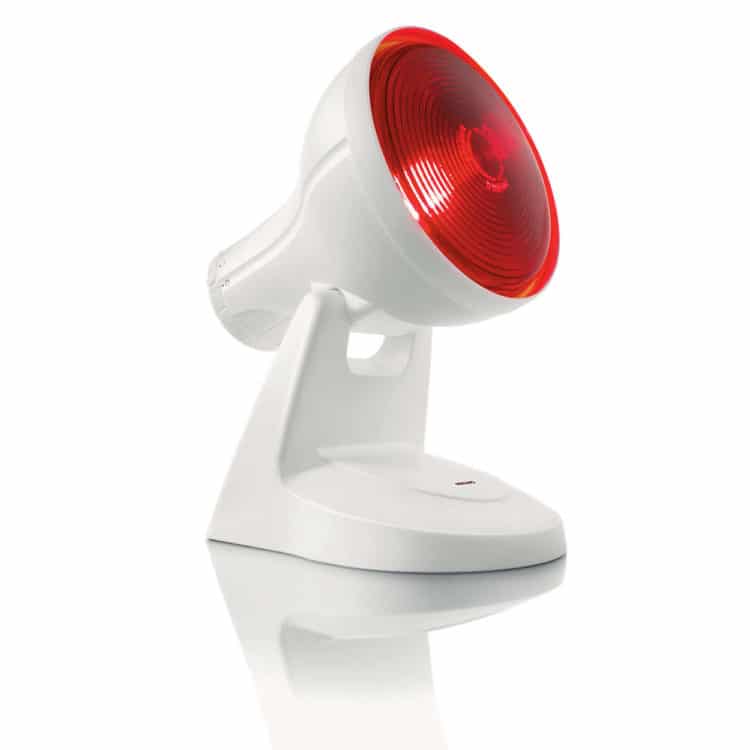

Infrared lamp therapy is one of those effective and useful physiotherapy procedures that can be easily performed at home.
Infrared radiation normalizes blood pressure and stimulates blood circulation in the brain, removes toxins from the body, helps to normalize the hormonal sphere, has anesthetic and anti-inflammatory effect.
What heals?
Therapy can be both local and general, and is prescribed if the patient has:
- Hair problems;
- Skin diseases (dermatitis, trophic ulcer, neurodermatitis, pemphigus, lichen);
- Pathology of the organs of vision;
- Frostbite and burns, long non-healing wounds;
- Respiratory diseases (runny nose, tonsillitis, pharyngitis, bronchitis);
- Neuritis, neuralgia;
- Inflammatory processes;
- Complications after injuries, pathology of the joints and the musculoskeletal system, contractures and infiltrates.
It is forbidden to use IR lamps if:
- the patient has a benign or malignant tumor;
- revealed blood diseases, open form of tuberculosis, individual intolerance;
- chronic diseases are acute;
- purulent processes are recorded in the body, but there is no outflow of the contents.
IMPORTANT! Pregnant and breastfeeding women are not recommended to come under the influence of infrared lamps!
In medical institutions, infrared cabins, electric bandage, coupled with thermal wrapping, and so on are used. You can buy a special lamp at home.
For drying car paint and working with plastics in a car service
Among the drying methods used for the car - natural, convection and infrared - the latter is the most productive and convenient.
Drying occurs from the inside, due to which there is no cracking of the surface, swelling of paint and other negative effects.
The presence of the control unit allows you to choose a convenient mode like each coating separately: primer, putty, varnish, enamel. Drying can also be used for the polymerization of powder paints, which until recently was only possible under factory conditions.
The most popular is the mobile infrared rack dryer with multiple emitters. You can also purchase a portable version. Both short-wave and medium-wave dryers are used: the drying time in the first case is from 5 to 15 minutes, in the second - from 12 to half an hour.
For heating greenhouses in the country
Infrared heaters are indispensable for growing plants in those regions of the country in which the daylight hours are short. Such heating does not require large physical and material costs, such as, for example, water, gas or convector heating, but the results of seed germination are 30–40% higher.
Thanks to infrared lamps, you can create several zones in the greenhouse with different temperature conditions, depending on the needs of the crops grown. They are resistant to temperature extremes, the influence of sprayed chemical reagents (including aggressive ones), mechanical stress, humidity. Moreover:
- the heating system is installed on the ceiling or walls, which allows you to free the greenhouse floor for other purposes
- no open flames and heating elements, so the risk of fire is minimal
- installation of IR lamps can be carried out by a simple user
Expert opinion
Izosimov Vladimir Nikolaevich
An electrician of the highest category. Lighting specialist.
Infrared lamps located under the ceiling are suitable for growing thermophilic crops in season. The equipment laid in the ground is suitable for the early cultivation of greens and seedlings and for warming up the soil after a long winter. It is worth spending on complex equipment only if the owner of the greenhouse plans to engage in floriculture or vegetable growing all year round.
For space heating
The IR lamp is well suited for heating small and medium-sized rooms: small private houses, offices, apartments. Devices are especially popular among summer residents.
- Lamps do not dry out the air and do not create convective air flows;
- Allow to leave a significant area available for use;
- There is no need to equip a ventilation outlet for combustion products in the room;
- Allow you to save up to 60% of financial costs for the consumption of energy resources;
- Power surges and power outages do not affect the devices;
- Improves the health of residents;
- The electromagnetic field from infrared lamps does not exceed the permissible level.
Expert opinion
Izosimov Vladimir Nikolaevich
An electrician of the highest category. Lighting specialist.
Do not use lamps with plastic sockets - the material will melt very quickly. The ideal option is ceramics.
For plants
Without enough light, plants weaken, stop growing and bloom, and eventually die. Artificial lighting is necessary not only for greenhouse pets, but also for residents of home pots and pots. Therefore, one cannot do without an infrared lamp in the period from late autumn to early spring.
Choose red and blue glasses: shades of red promote the development of stems and leaves, and blue - the branching of rhizomes.
IMPORTANT! The distance between the plants and the lamp must be at least 150 cm.
For heating animals
Infrared lamps are used to heat young piglets, poultry, kids and lambs. They stimulate the growth of animals and birds, clean the space, dry the bedding. Basic rules of use:
- the light source must be equipped with a power regulator;
- the temperature at the place of heating should be in the range of 25–32 degrees;
- it is not recommended to turn on / off the device often;
- do not forget to clean the surface of the flask from dust from time to time, otherwise the accumulated dirt will cause the device to overheat and burn out.
The most popular brands for this purpose are Philips, Osram, IKZ, IKZK.
For brooder
Infrared film is best suited for heating a brooder for chicks: the heat emanating from the radiator gently and gently warms the eggs, there is no risk of overheating or hypothermia. The film is placed either down under the tray, or fixed on the sides of the incubator and on the ceiling. Fix the rug with tape or self-tapping screws.
Expert opinion
Izosimov Vladimir Nikolaevich
An electrician of the highest category. Lighting specialist.
For delicate creatures such as chickens, a regular IR lamp is not suitable. If installed incorrectly, it greatly irritates the eyes of the chicks, and it is difficult to install the device according to the rule due to the specifics of the place. In addition, there is a risk of babies crowding near a heat source, which is fraught with crush and loss.
For soldering station
For stations, quartz or ceramic infrared emitters are used. Quartz crystals are strong and durable, well suited for long term performance.
Ceramic quickly reach the desired temperature (in 20-30 seconds), but much more fragile. They are best used with frequent switching on and off, and with intermittent processes.
For flowers
The rules for using IR lamps for flowers are the same as for greenhouse plants. But they should be placed only on top to prevent the barrel from curving. The permissible distance from the light source to the plant is 15-30 cm.
REFERENCE! Light-loving flowers (tradescantia, monstera, phalaenopsis, dracaena, gloxia) should be placed closer to the center.
For sauna
An infrared sauna heater is used if it is not possible to build a full-fledged stove. It looks like a metal case with a screen, a heat-insulating layer, a reflector and a heating element. The most popular: Russian "Pion", "Ecoline", "Master Hit" "Ballu"; Italian "ITM" and AEG "; German "WAGO", "Eckerle", "Kroll"; French "Thermor", "Noirot".
It is best to install the equipment in the sauna vertically and so that a single heat flow is obtained.The heating element can be ceramic (service life of only 4 years), tubular (service life is 6–7 years) or carbon fiber (up to 10 and more).
Expert opinion
Izosimov Vladimir Nikolaevich
An electrician of the highest category. Lighting specialist.
30 minutes spent in a steam room with an IR lamp is equivalent to 2 hours in an ordinary Russian bathhouse.
Terms of use
The simplest day-to-day care of ceiling-type halogen devices is that they are inaccessible to mechanical damage and children, therefore, they only need to be kept clean.
Wall and floor models must be located at a distance of at least 1 m from surrounding objects; it is strictly forbidden to place any objects on the heaters for drying or heating. In addition, it is also forbidden to cover the heating devices with anything, as this can lead to ignition of the coating, getting a thermal burn from contact with it or overheating of the device.
Do not stay under the influence of the radiation flux in the immediate vicinity of the heater for a long time - you can get burned. In addition, the radiation from halogen lamps is shortwave, and prolonged human exposure is undesirable.
Important! If the area of the heated room is significant, then the use of several low-power halogen heaters will be optimal to ensure a comfortable temperature regime in the room, since the use of one device of total power has more negative factors.
It is advisable to purchase a halogen heater with lamps that have a special coating that weakens their glow when heated.

